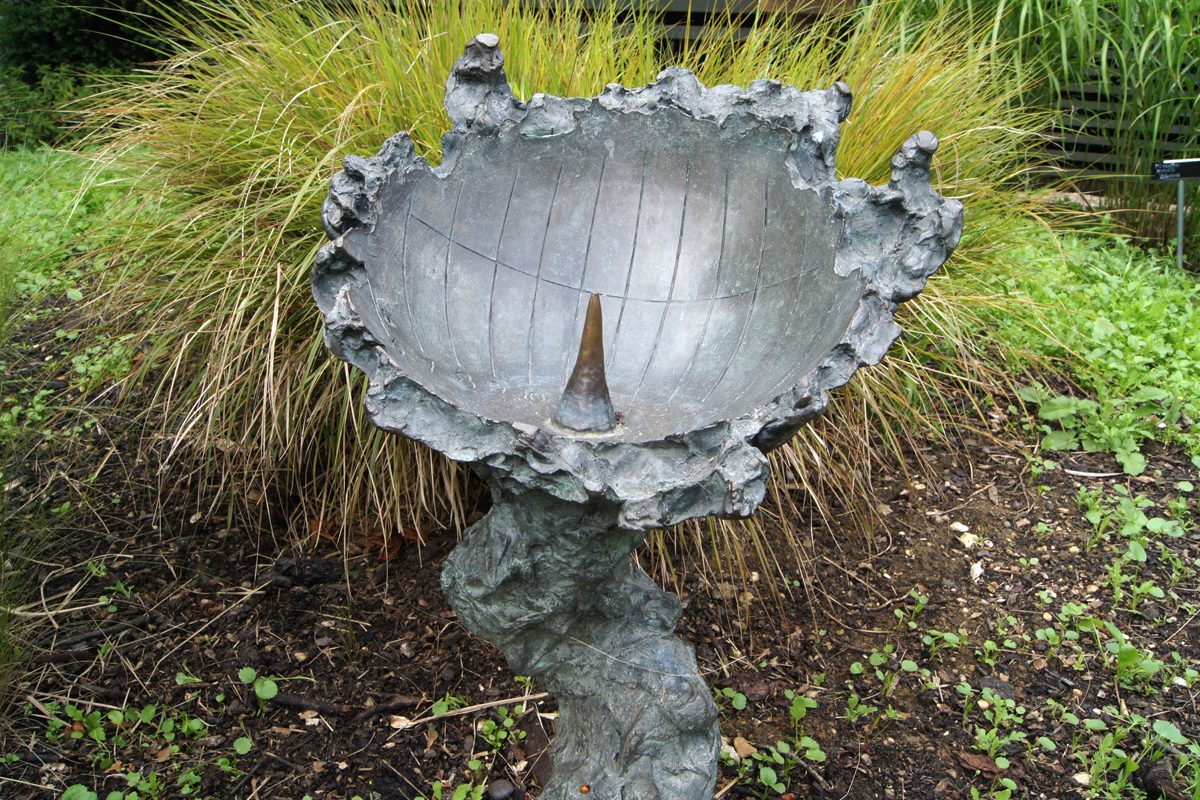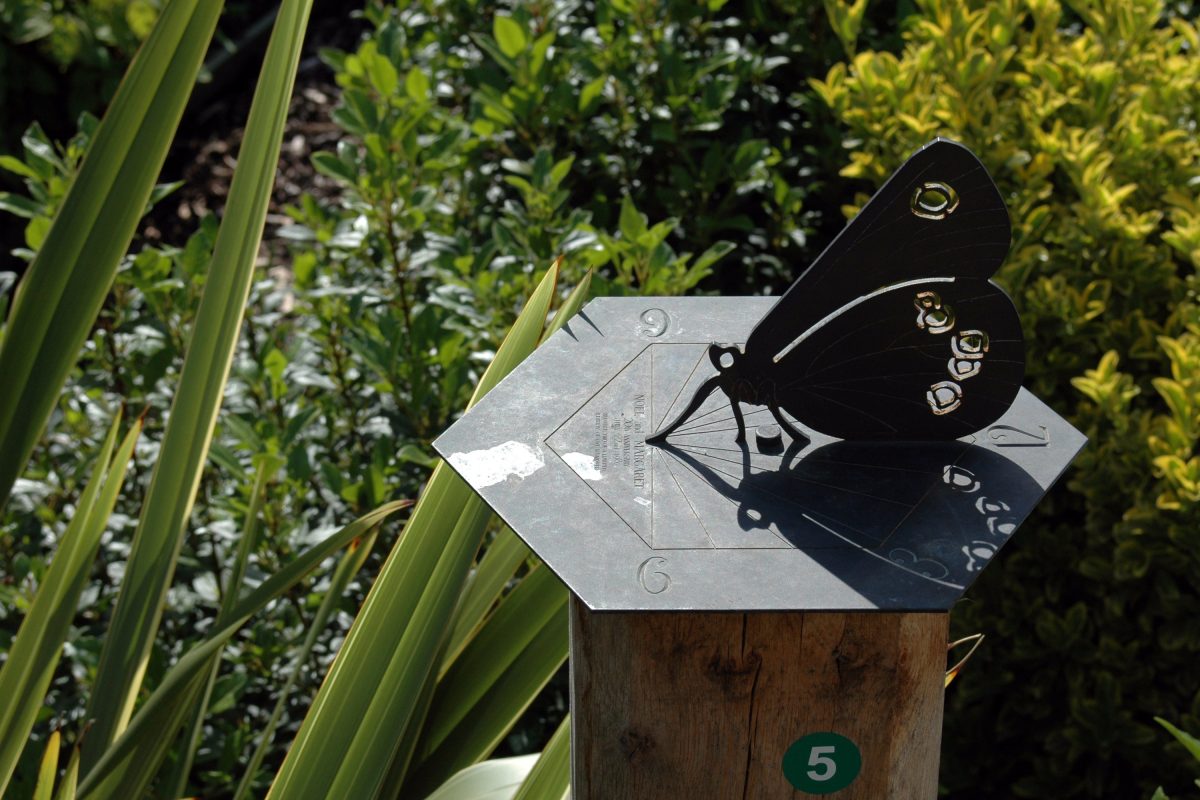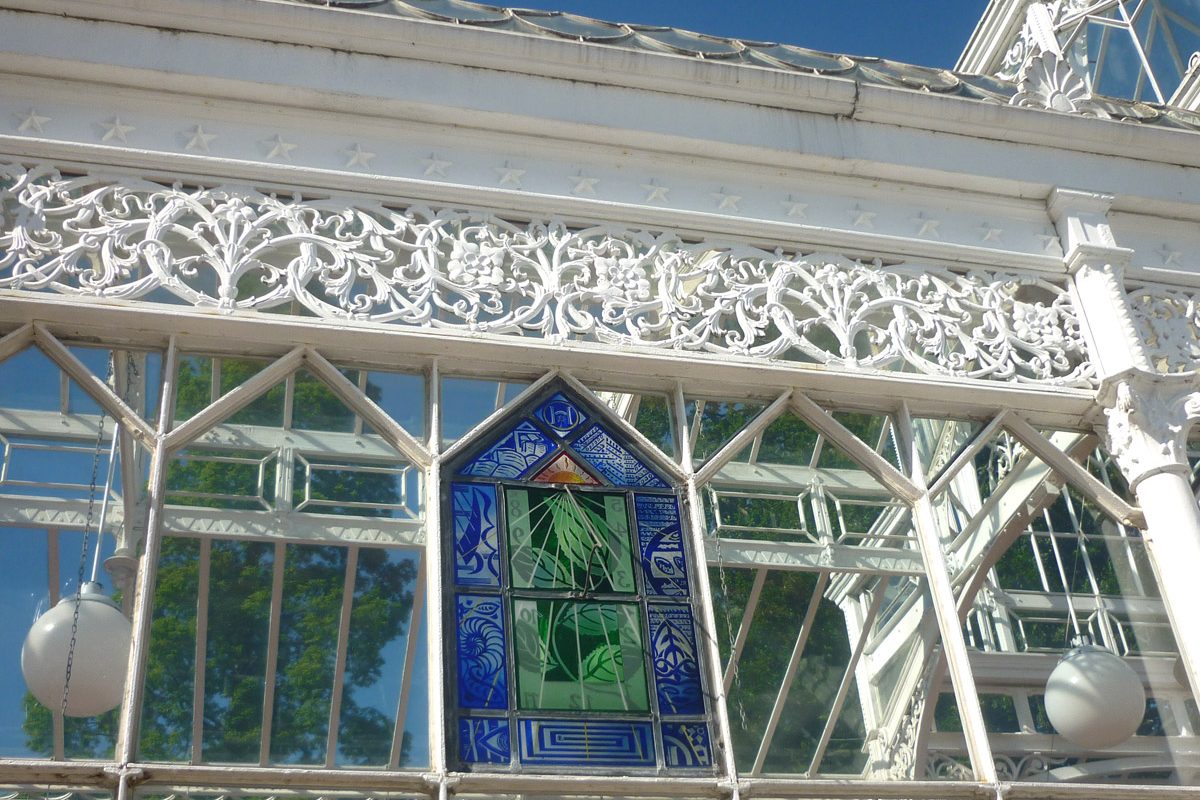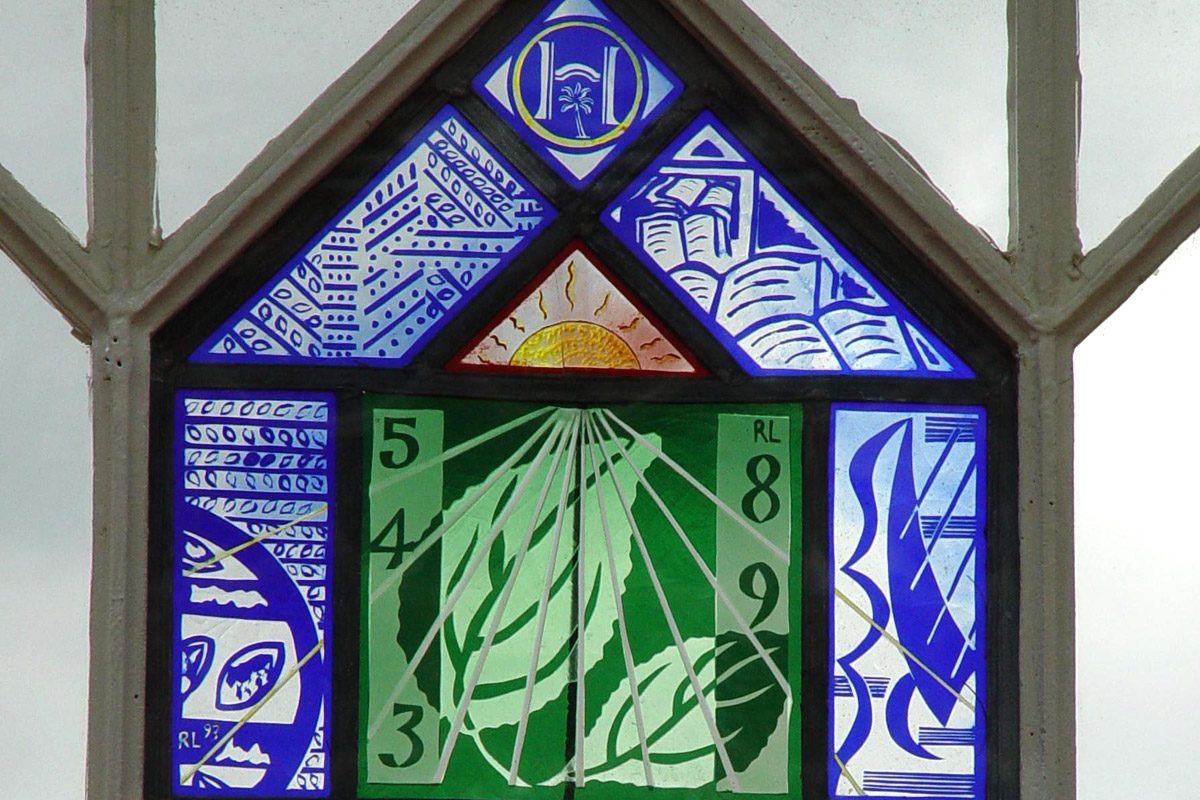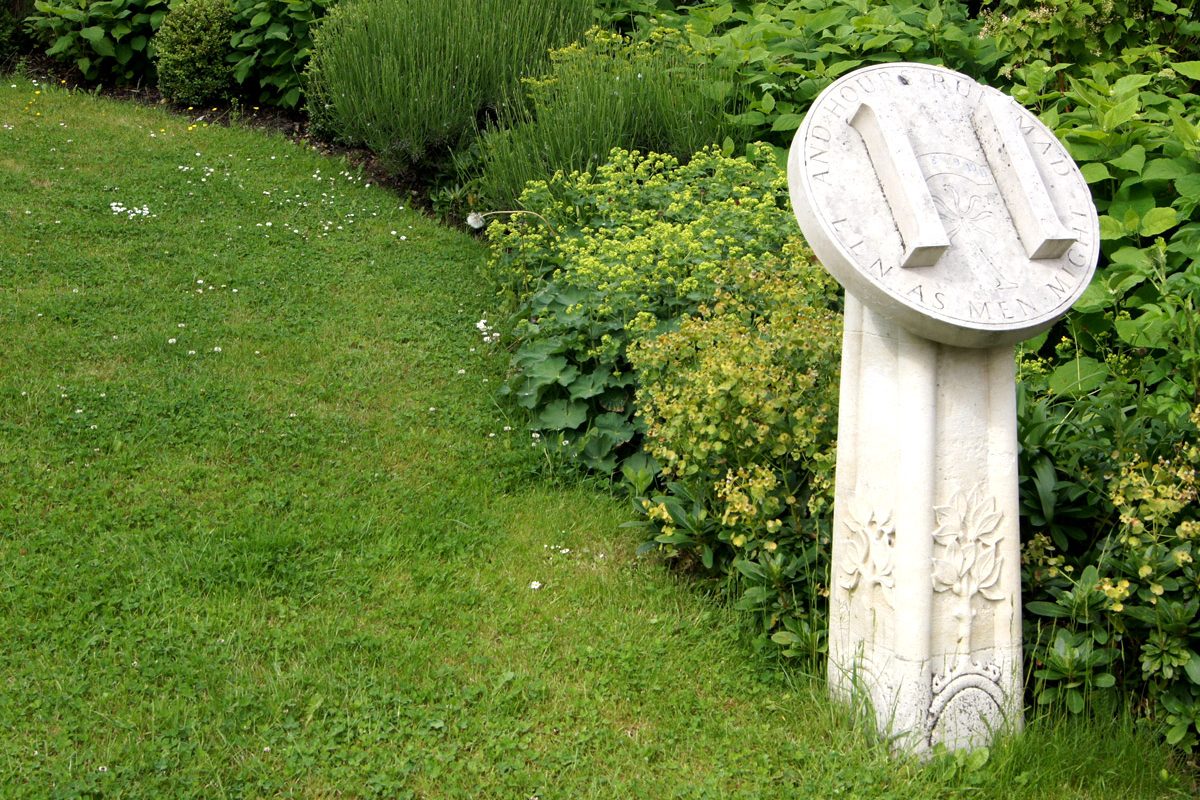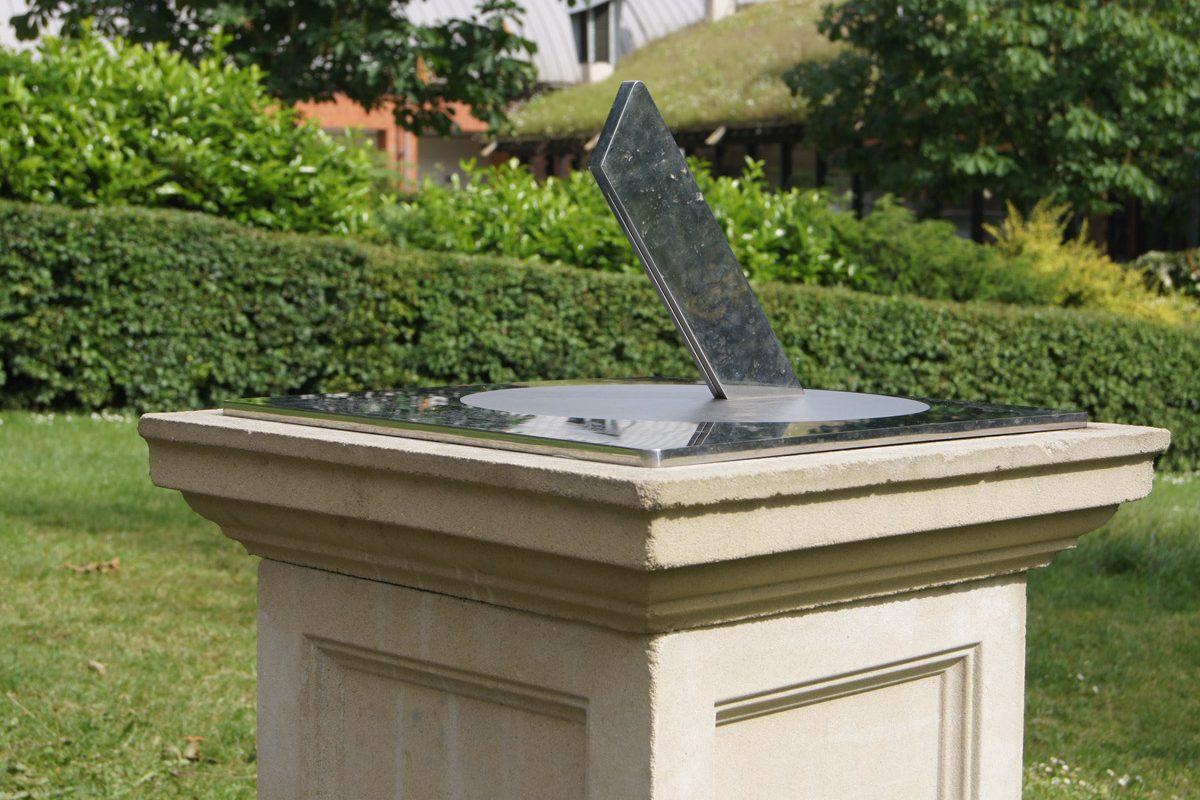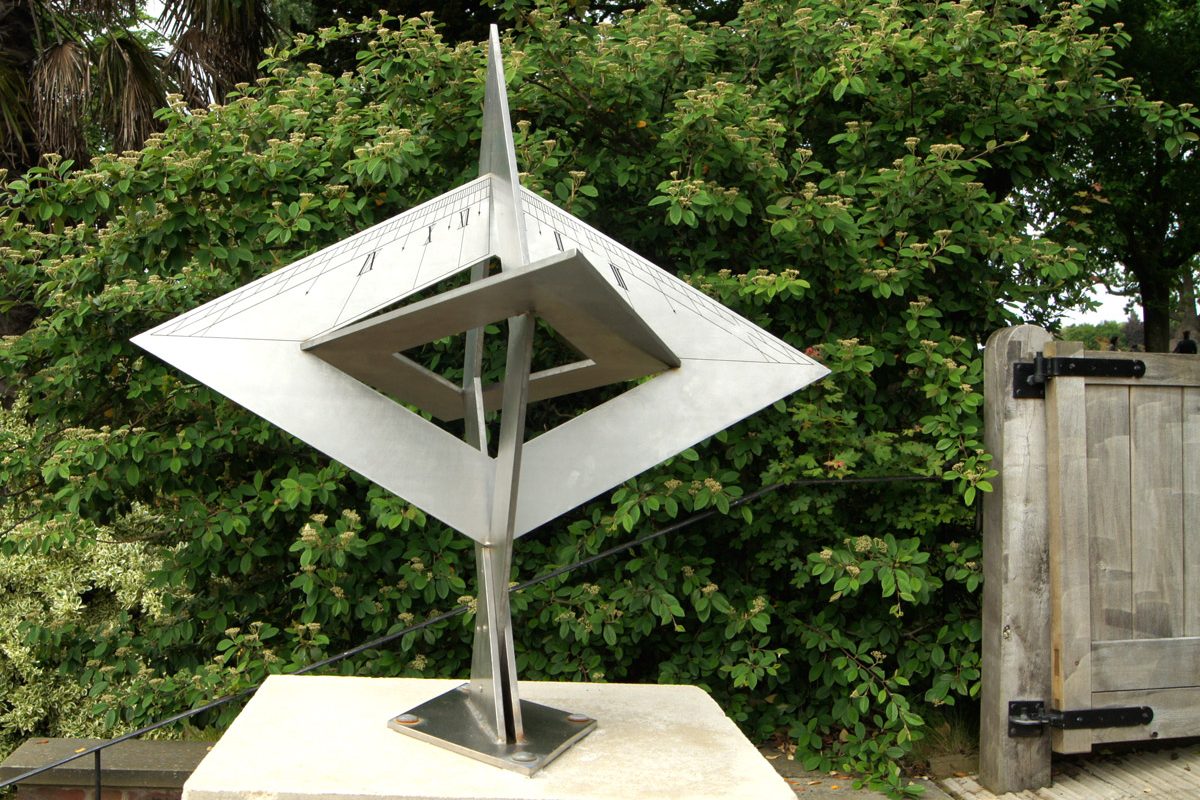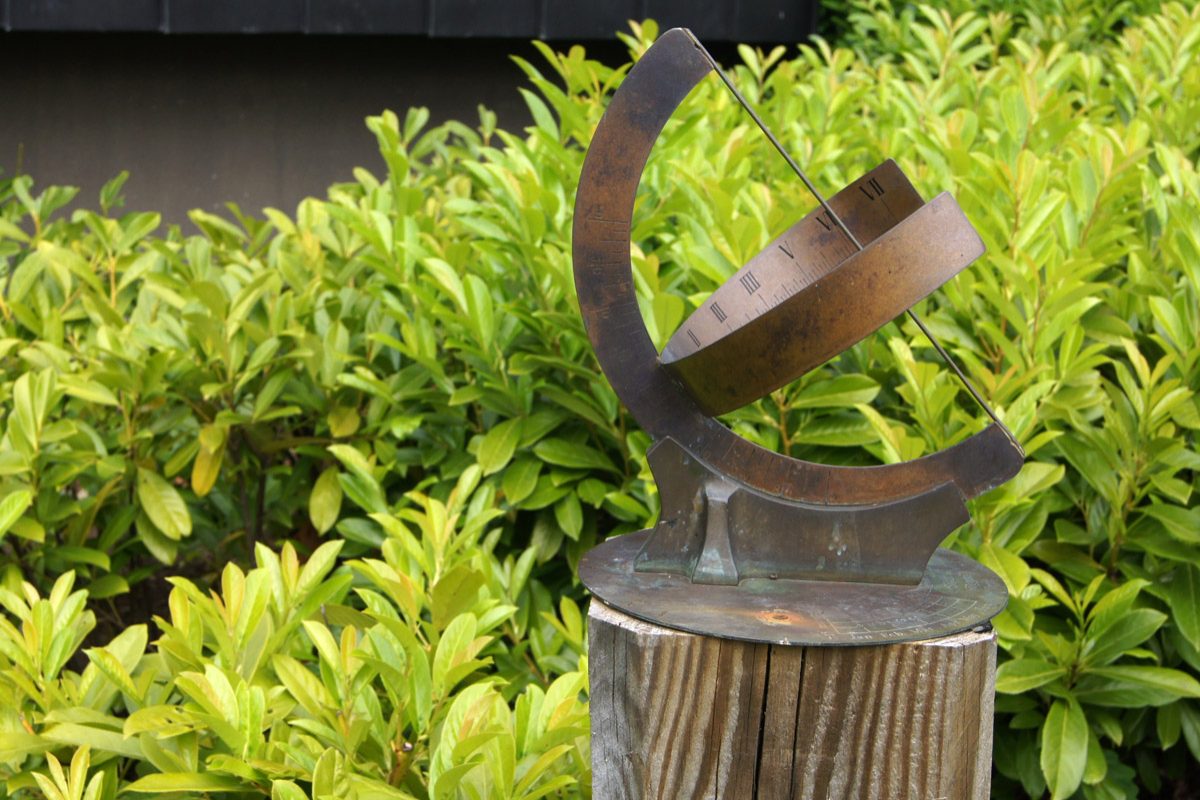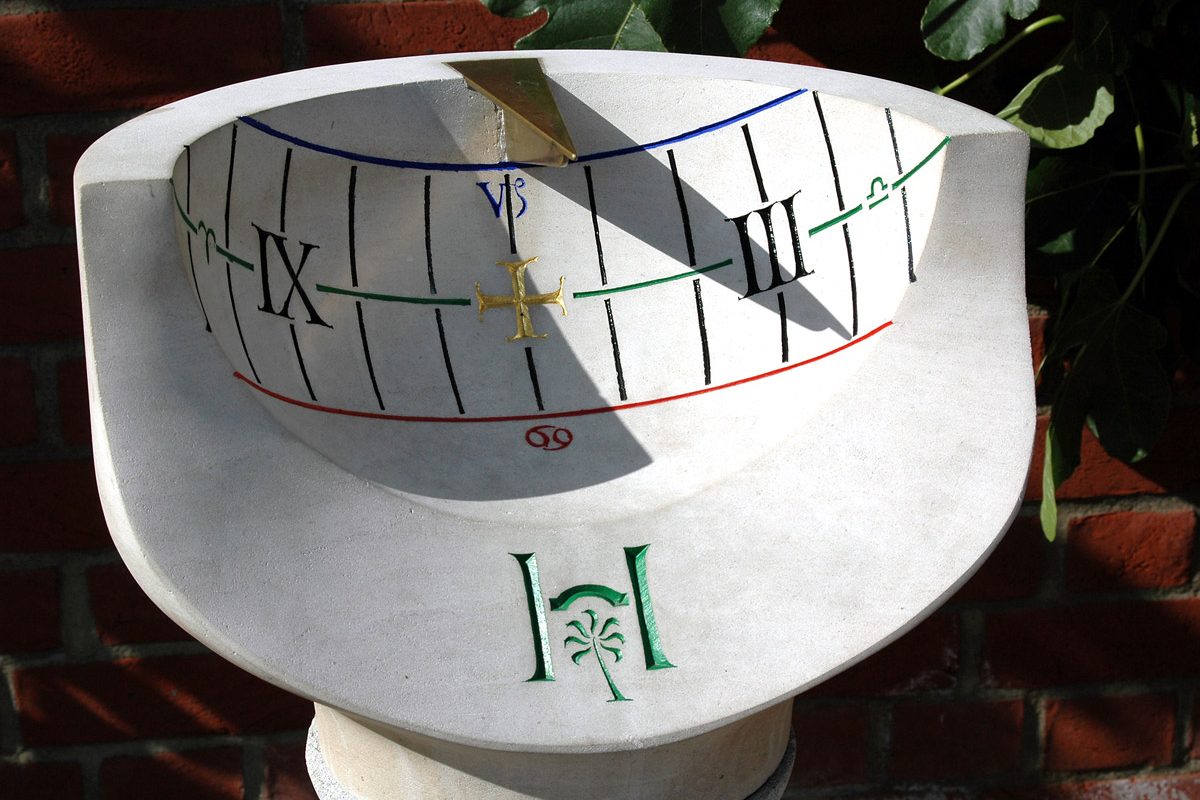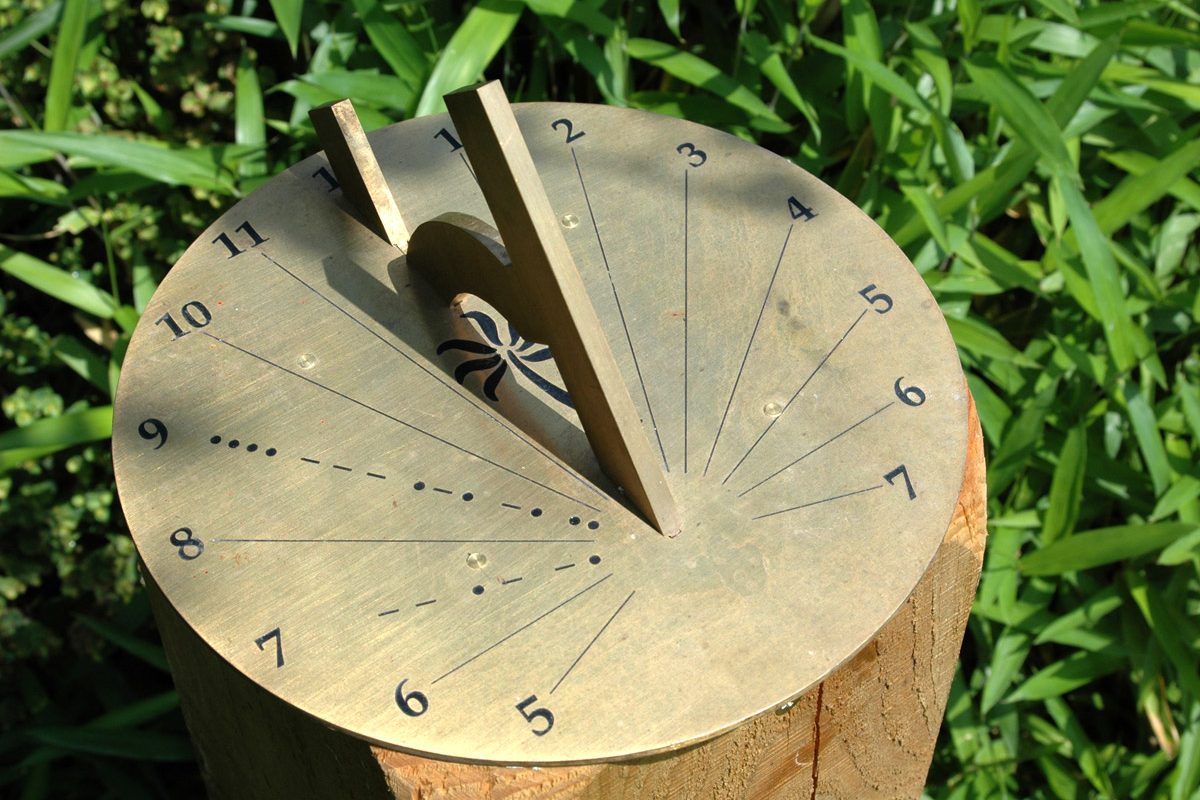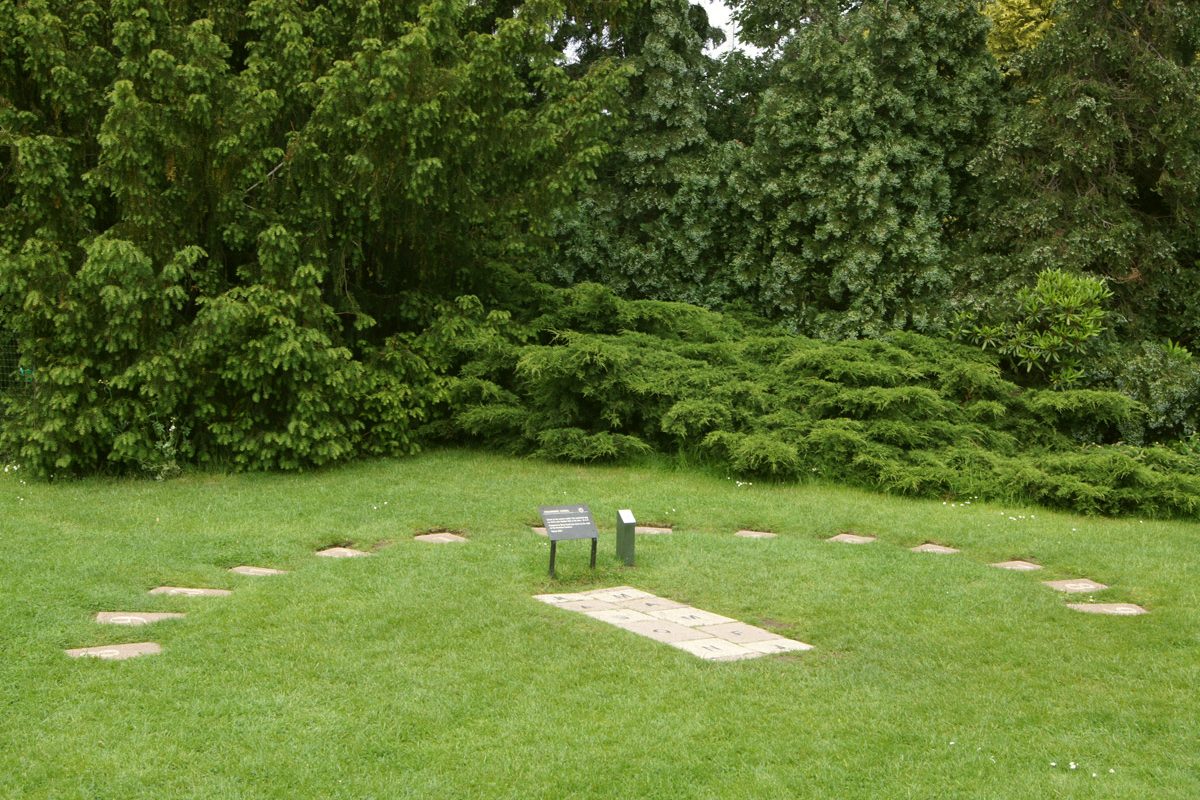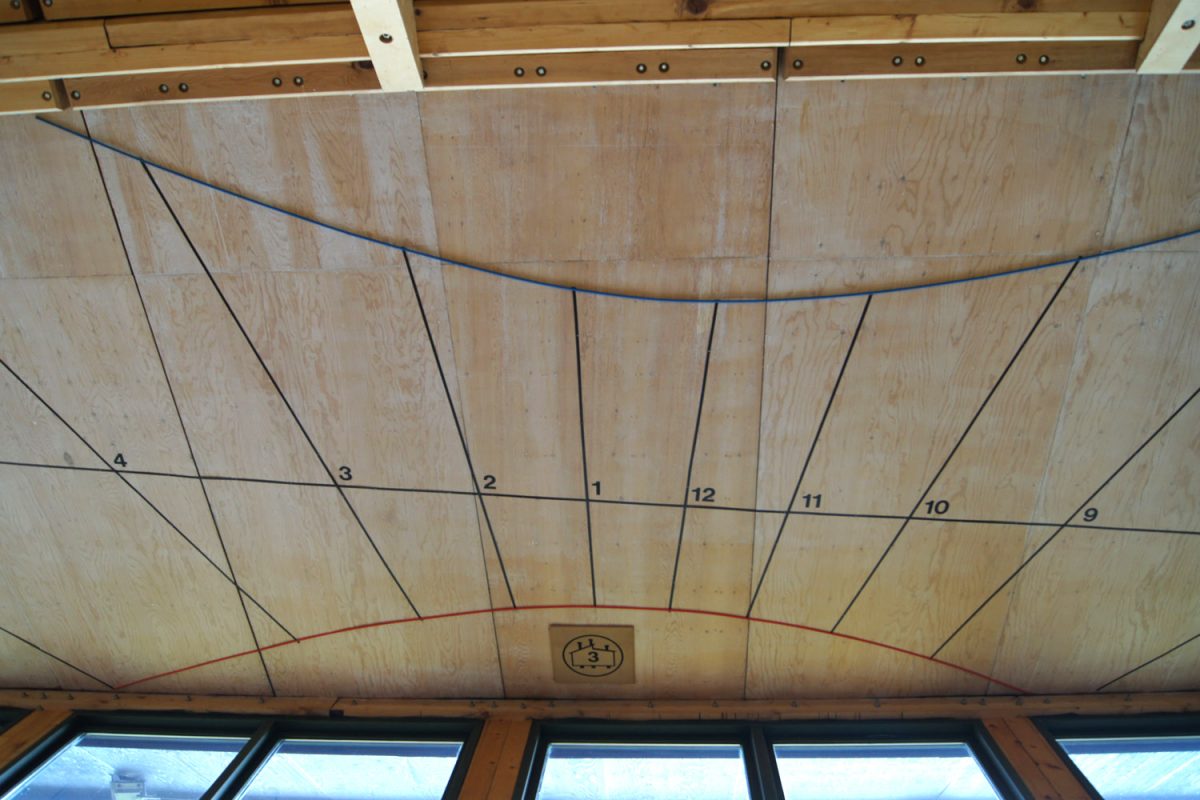How to read a sundial
Sundials usually show time by a shadow created by the gnomon.
The gnomon is the part of the sundial which casts the shadow acting as the clock hand. Sundials are usually delineated to read solar time.
Solar time changes slightly from day to day due to the tilt of the earth and its elliptical orbit around the sun, whereas clock time – which we use on a daily basis in our lives – is based on each day having 24 hours of equal length.
The difference between solar and clock time is called the Equation of Time. Sundials show solar time, so depending on the date you need to add or subtract a few minutes to get clock time.
During British Summer Time, you need to add one hour to the time shown on the sundial.
- Design: Angela Hodgson
- Delineator: Dick Andrews, 1994
The organic design of this dial juxtaposes the smooth surface of the spherical inner bowl with the disorganised, decaying appearance of the outer bowl and stem.
This symbolises the conflict between ‘perfect’ human ideals and the death and decay the passage of time brings. The plant like shape of the dial’s stem was inspired by the Chinese Magnolia flower (Magnolia X Soulangiana).
In order to find the lowest central point of the bowl a marble was rolled around inside it and the gnomon placed on the point on which the marble rested.
Reading the dial
The tip of the shadow created by the gnomon indicates solar time.
Where to find this sundial
The Scaphe Sundial is number 1 on the map, and is on the path from the Clocktower.
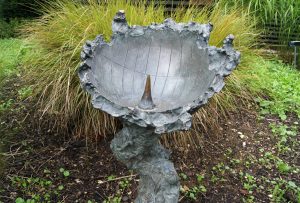
- Design: Edwin Russell
- Construction: Brookbrae Ltd, 1994
This is a limited edition dial originally designed for the Sunday Express Garden at the Chelsea Flower Show 1987 demonstrating the combination of science and art.
The dial commemorates the 20th wedding anniversary of sundial enthusiast Noel Ta’Bois. It was given to the Horniman after his death in 1988.
Reading the dial
The edge of the shadow of the butterfly’s wing indicates Solar Time.
Where to find this sundial
The Horizontal ‘Butterfly’ Sundial is number 2 on the map, and sits in the Garden next to the Museum entrance path.

- Design: Roselyn Loftin
- Delineator: David Young, 1993
A feature of the Conservatory, the dial faces slightly west of south.
The design of the dial symbolises elements of the Museum. Each blue panel represents a different Horniman collection and the green panel, the Gardens.
The gnomon is situated on the outside of the Conservatory creating a shadow that can be seen from inside the building.
Reading the dial
This dial is designed to be read from inside the Conservatory. The time is indicated by the gnomon’s shadow on the glass. The layout shows the morning hours on the right and afternoon hours on the left (the reverse of most vertical sundials).
Underneath this dial at the base of the Conservatory you can also see the original plaque explaining the ‘Equation of Time’.
Where to find this sundial
The Vertical Stained Glass Dial is number 3 on the map, and be found on the Conservatory.
The Conservatory may not open to the public (it is used as a venue hire space), although the sundial can be seen from the outside, and through the glass.
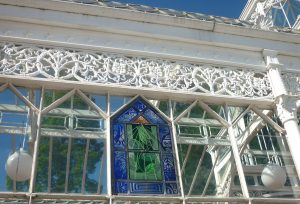
- Design and construction: John Moir, 2005
Most vertical dials are found on the sides of buildings. The Tea-time dial is tucked just behind the conservatory on a brick wall.
It faces slightly north of west. Technically, this is known as a declining dial as it does not face directly south.
The dial captures traditional summer afternoon tea hours from 2.30 to 6pm. The gnomon is the short metal pole near the top of the wall with a red ball attached.
Reading the dial
Time is indicated by the shadow of the ball cast against the wall moving upwards through the afternoon. The dial is calibrated for British Summer Time so you do not need to add an hour to the time shown.
Where to find this sundial
The Vertical Tea-time Sundial is number 4 on the map, and is on the wall behind the Conservatory.
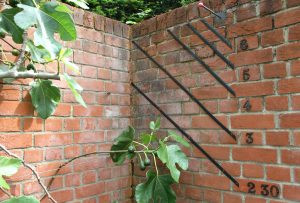
- Design and construction: John Moir and Richard Klose, 1997
A Polar dial has both the dial plate and the gnomon parallel to the earth’s polar axis, the latter creating a shadow which moves sideways across the dial plate.
The Horniman dial is, in effect, two separate polar dials, with two gnomons and two overlapping hour scales. The edges of the ‘H’ act as the gnomons.
This sundial features a motto about the passage of time – a common feature of sundials. The motto is an anagram of ‘The Horniman Museum and Gardens’’ and reads: ‘And hours run mad e’en as men might’. The dial features a letter H, inspired by a previous Horniman logo. The plinth design was inspired by the Horniman Clock Tower and evokes Arts and Crafts style. The dial is made from Hopton Wood limestone and the plinth from Portland stone.
Reading the dial
The shadow of the right hand gnomon shows solar time on the blue (am) scale while the shadow of the left hand gnomon indicates solar time on the red (pm) scale.
Where to find this sundial
The Double Polar Horniman Logo Sundial is number 5 on the map, and sits in the small Garden next to the Conservatory.
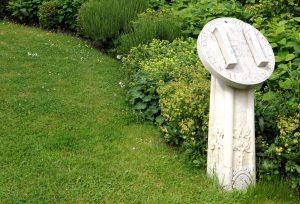
- Design and construction: Piers Nicholson, 2004
- Plinth donated by Acanthus Cast Stone Products
Spot-on dials create a clear and precise shadow whose outside edge indicates solar time.
The markings indicate time in 5-minute segments. The slit through the gnomon produces a line of light across the dial at solar noon which indicates the direction of True North.
These features ensure that the sundial can be positioned and therefore read within a minute or two of accuracy.
Reading the dial
The time indicated by the outer edge of the shadow indicates solar time.
Where to find this sundial
The Horizontal Spot-on Sundial is number 6 on the map and sits between the Avenue and the Grasslands Garden.
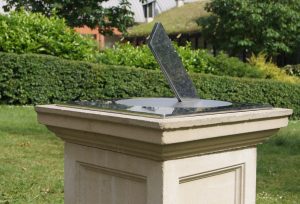
- Design: David Young and John Moir, 2007
- Construction: Tony Moss, 2008
This unusual dial consists of three interlocking diamonds, based on Borromean rings – three rings which are linked together but become separated if one is removed. This motif, which you can see engraved on the dial, has often been used to symbolise strength and unity.
Reading the dial
The central vertical diamond acts as the gnomon casting a shadow onto hour scales engraved on the other two diamonds. Between the hours of 9am to 3pm, the gnomon’s shadow falls on the vertical hour scale facing the reader. Before 9am and after 3pm, the gnomon’s shadow falls on the horizontal hour scale.
Where to find this sundial
The Armillary Octahedron Sundial is number 7 on the map, and you can find it next to the Sunken Garden terraces.
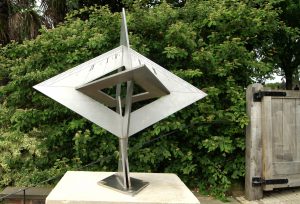
- Design and construction: Silas Higgon,1994
Equatorial dials have their gnomons aligned to the earth’s Polar North-South axis and the hour scales (delineated as circles) are parallel to the plane of the equator.
The gnomon’s shadow progresses at the same rate as the Earth’s rotation – 15 degrees per hour. A graph depicting the Equation of Time is engraved on the sundial’s base plate.
Reading the dial
The rod gnomon crossing the centre casts a sharp line of shadow across the circular hour scale giving Solar Time.
Where to find this sundial
The Equatorial Sundial is number 8 on the map, and you can find it in the bushes by the Pavilion.
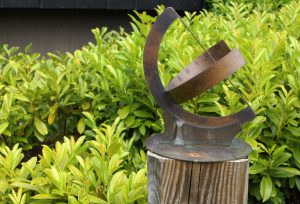
- Design and construction: David Brown, 2004
In Roman times, days were divided into 12 hours between sunrise and sunset. The length of an hour could therefore change, depending on the length of daylight throughout the seasons.
This particular dial has been designed in the style of a Roman timepiece, but has been specially delineated to read hours of equal length, which we use today.
As well as indicating the hours of the day, the Roman sundial marks seasonal equinoxes and solstices. The tip of the shadow touches the central green line on the equinoxes, the lower red line on the Summer Solstice and the upper blue line on Winter Solstice.
Reading the dial
The tip of the gnomon’s shadow indicates solar time.
Where to find this sundial
The Roman Sundial is number 9 on the map, and you can see if opposite the Bandstand in the pollinator flower beds.
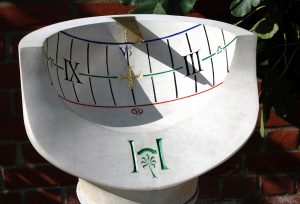
- Design: John Moir
- Construction: Ray Ashley
This dial is sited where the Horniman family house once stood. The gnomon’s shape is based upon the ‘H’ from the old Horniman Museum logo.
The word Horniman is written in Morse Code in place of the lines indicating 9 and 7 o’clock which celebrates the date 1897 – the year in which the Gardens were first opened to the public.
Reading the dial
The edge of the shadow created by the ‘H’ shaped gnomon indicates solar time.
Where to find this sundial
The Horniman Sundial is number 10 on the map, next to the Prehistoric Garden.
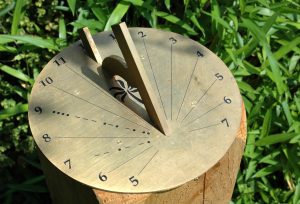
- Design: Barry Small
- Construction: Staff at Horniman Museum and Gardens, 1992
Analemmatic dials are dials with horizontal dial plates and vertical gnomons. The hours are arranged in an elliptical shape and the gnomons are movable or so the time can be read accurately throughout the year.
This sundial is formed by a set of stone slabs set into the ground, each slab representing an hour of the day. Facing this semi-circle is a central paving slab aligned North to South, on which the months of the year are marked.
Reading the dial
Stand on the central line of the slab adjacent to the correct month as a human gnomon. Your shadow will indicate the time. This dial has been delineated for British Summer Time so you need to deduct one hour when Greenwich Mean Time is in force.
Where to find this sundial
The Analemmatic Sundial is number 11 on the map, next to the Prehistoric Garden.

- Design and Construction: John Moir and Ray Ashley
The CUE building at the Horniman houses a rare ceiling dial inside the library.
Similar to the Roman Dial, this ceiling dial also indicates the Summer and Winter Solstices and the Equinoxes with coloured lines.
Reading the dial
The dial is read by the reflected point of light on the ceiling where the hours are marked.
Where to find this sundial*
The CUE Building ceiling sundial is number 12 on the map, and is on the ceiling inside the CUE Building.
*You can only view this dial by appointment with our Library staff or on Library Open Days on the first Sunday of the month.
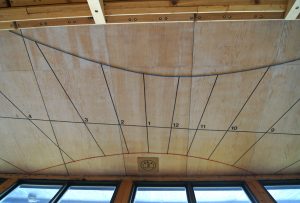
The British Sundial Society was established in 1989 and seeks to promote the knowledge of the science, history, art and craft of sundials.
As well as maintaining a database of sundials in Britain, the society actively publishes research in their quarterly journal The Bulletin.
